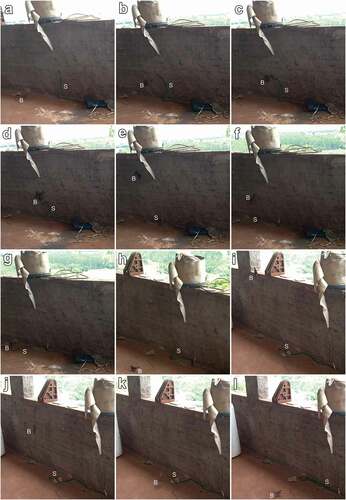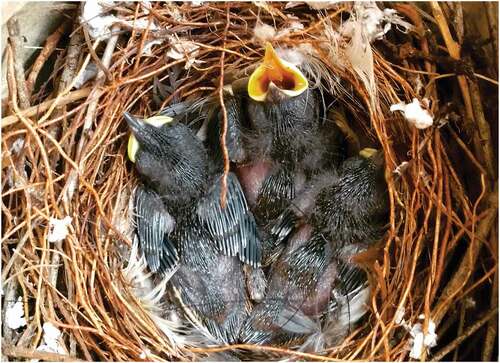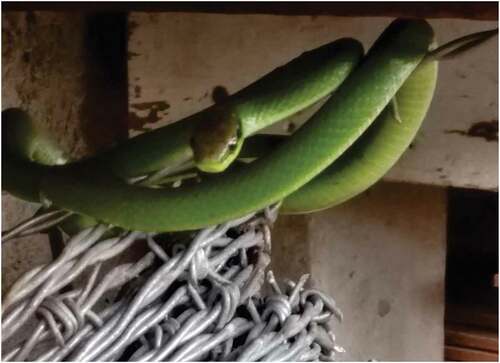ABSTRACT
Snakes are common predators of birds. However, reported cases of snake predation on Troglodytes musculus are scarce. Here, we report a predation attempt of a Troglodytes musculus nestling by the dipsadid snake Philodryas olfersii. We also present a list with bird species recorded as prey of this snake species. We found 25 predation events of P. olfersii on adult, juvenile, and nestling birds. A total of 19 bird species from 14 families have been reported as prey of P. olfersii. Most predation events occurred on the vegetation, while some others were observed on the ground, cage, and artificial nest.
Serpentes são predadores comuns de aves. No entanto, casos relatados de predação de Troglodytes musculus por serpentes são escassos. Aqui, relatamos uma tentativa de predação de um filhote de Troglodytes musculus pela serpente Philodryas olfersii. Também apresentamos uma lista de espécies de aves registradas como presas dessa espécie de serpente. Encontramos 25 eventos de predação de P. olfersii sobre aves adultas, juvenis e filhotes. Um total de 19 espécies de aves pertencentes a 14 famílias foram relatadas como presas de P. olfersii. A maioria dos eventos de predação ocorreu na vegetação, enquanto alguns outros foram observados no solo, gaiola e ninho artificial.
The Neotropical dipsadid Philodryas olfersii (Lichtenstein 1823) is a medium-sized venomous, semi-arboreal and diurnal snake widely distributed throughout South America, where it occurs in Argentina, Bolivia, Brazil, Colombia, French Guiana, Guyana, Paraguay, Peru, Uruguay, and Venezuela [Citation1,Citation2]. It inhabits mainly forest and forest edge habitats [Citation3], but can also be found in swampy and agricultural areas as well as in the vicinity of human habitations [Citation4–7]. As a generalist predator, P. olfersii preys on a wide variety of small vertebrates such as frogs, lizards, snakes, birds, rodents and bats [Citation8–11].
Snakes employ two foraging strategies to hunt prey – active searching and ambush [Citation12,Citation13]. They are common predators of birds, with their predation on nestlings being one of the main causes of nest failure for most birds [Citation14,Citation15]. However, reported cases of snake predation on adults and nestlings of passeriform Troglodytes musculus Naumann, 1823, are scarce [Citation16,Citation17].
Troglodytes musculus is recognized as a species distinct from Troglodytes aedon Vieillot, 1809, by the Brazilian Ornithological Records Committee [Citation18], although BirdLife International [Citation19] does not acknowledge this distinction and treats T. aedon as a single species living throughout the Americas. Troglodytes musculus often builds nests in natural cavities or among human construction, such as on walls and under tiles [Citation20]. It uses grass and/or roots to install nests, depending on the place they have chosen, and incubates 3 to 7 eggs, which hatch after 15 days [Citation20,Citation21]. Here we reported a predation attempt of a Troglodytes musculus nestling by the dipsadid snake Philodryas olfersii, and provide a list of bird species recorded as prey of this snake.
Field observation was performed in the rural zone of the municipality of Assaí, northern Paraná State, southern Brazil (−23.4709°S, −50.8926°W, Datum WGS 84). A bibliographic search was conducted using Google Scholar to summarize the records of P. olfersii predating individuals of other bird species. The search terms used were: “Philodryas olfersii”, “diet”, “feeding behavior” and “birds”. Natural history notes published in Atualidades Ornitológicas, Herpetological Bulletin, Herpetology Notes, and Herpetological Review were also searched for predation records. Photos and videos of predation records were also obtained from WikiAves (https://www.wikiaves.com.br/) and YouTube (www.youtube.com).
At 14:30 h on 28 December 2018 an adult P. olfersii was observed trying to reach a nest of T. musculus containing three nestlings in the backyard of a house in the rural zone of the municipality of Assaí (). The nest was located inside a cylindrical cardboard container on top of a short wall. While unsuccessfully trying to climb the wall, the snake was mobbed by an adult T. musculus (https://www.youtube.com/watch?v=AyRA_wsYh9Q&feature=youtu.be). The adult bird uttered alarm calls, displayed approaches and attacked three times by pecking the snake in the head (). Disturbed by the mobbing behavior, the snake took shelter on a roll of barbed wire below a table near the wall. The snake remained motionless with its head directed towards to the cardboard container (). After some minutes, the snake then climbed the table, reached the wall and entered into the cardboard container with the nest. While was holding one of the three nestlings, it was mobbed by the adult bird, at which point the property owner removed the snake from the cardboard container and killed it.
Figure 2. Sequence of images showing Philodryas olfersii being mobbed by Troglodytes musculus. The position of the bird is indicated by the letter B, while the position of the snake is indicated by the letter S. (a) Adult of T. musculus preparing to attack an individual P. olfersii. (b) Bird flying toward the snake. (c) Bird strikes the snake. (d) and (e) Snake retreats after the attack. (f) and (g) Second attack by bird. (h) and (i) Bird flies and lands on top of the wall and then utters an alarm call. (j) and (k) Third attack by bird

Our review of the literature and photos and videos of predation records uncovered 25 events of P. olfersii preying upon adult, juvenile and nestling birds (). These 25 records reveal that 19 bird species belong to 14 families have been reported as prey of P. olfersii. Thraupidae was the family with the greatest number of reported predation events with seven records. Most of the predation events occurred on vegetation, although some cases occurred on the ground, in a cage or in an artificial nest ().
Table 1. Bird species reported as prey of Philodryas olfersii.
Among snakes of the genus Philodryas, only Philodryas chamissonis, P. nattereri and P. patagoniensis have been reported as predating nestlings of Troglodytes aedon and T. musculus [Citation17,Citation22,Citation23]. There were no reports of T. musculus as prey of P. olfersii among the 25 predation events obtained from the literature and photos and videos of predation records. Therefore, this reported case adds P. olfersii to the list of predators of T. musculus.
Philodryas olfersii is a green snake that actively forages both on the ground and among vegetation [Citation2]. In southern Brazil, P. olfersii has been reported to prey mainly on nestlings [Citation2]. The present study, however, found adults and nestlings to account for most records of predation by P. olfersii (see ), which seems to reflect its generalist feeding strategy and the availability of these prey items in the habitats where this snake species is found [Citation2,Citation4,Citation24]. Furthermore, the higher number of bird predation events that occurred in vegetation is associated with foraging strategies and camouflage of P. olfersii in this type of microhabitat, which favors hunting for prey and avoiding visually oriented predators [Citation2].
Potential prey employ mobbing behavior in an attempt to confound, distract or physically attack the predator [Citation25,Citation26]. In southeastern Brazil, attempts by P. olfersii to prey on birds were hindered by a group of mockingbirds (Mimus saturninus) that displayed mobbing behavior towards the snake [Citation24]. Although mobbing by a group increases the chances of hindering predation [Citation24], the mobbing behavior displayed by the single adult T. musculus did not prevent P. olfersii from trying to prey one of the nestlings.
Philodryas olfersii occasionally preys on adult and nestling birds living in cages and artificial nests in human habitations near native vegetation [27,28, this study]. As observed in the present study, individuals of P. olfersii can be killed by humans while actively searching for prey in human habitations, while in other cases humans can be envenomed by the snake [Citation27–29].
Disclosure statement
No potential conflict of interest was reported by the authors.
Additional information
Funding
References
- Nogueira CC, Argôlo AJS, Arzamendia V, et al. Atlas of Brazilian snakes: verified point-locality maps to mitigate the wallacean shortfall in a megadiverse snake fauna. S Am J Herpetol. 2020;14( SpecialIssue, 1):1–274.
- Hartmann PA, Marques OAV. Diet and habitat use of two sympatric species of Philodryas (Colubridae), in south Brazil. Amphibia-Reptilia. 2005;26(1):25–31.
- Sazima I, Haddad CFB. Répteis da Serra do Japi: notas sobre história natural. In: Leitão-Filho HF, Morellato LPC, editors. História natural da Serra do Japi. Campinas (SP): Editora da Unicamp; 1992. p. 212–232.
- Sazima I, Marques OAV. A reliable customer: hunting site fidelity by an actively foraging neotropical colubrid snake. Herpetol Bull. 2007;99:36–38.
- Sawaya RJ, Marques OAV, Martins M. Composição e história natural das serpentes de Cerrado de Itirapina, São Paulo, sudeste do Brasil. Biota Neotrop. 2008;8(2):127–149.
- Mesquita PCMD, Passos DC, Borges-Nojosa DM, et al. Ecologia e história natural das serpentes de uma área de Caatinga no nordeste brasileiro. Pap Avulsos Zool. 2013;53(8):99–113.
- Oda FH, Ávila RW, Drummond LO, et al. Reptile surveys reveal high species richness in areas recovering from mining activity in the Brazilian Cerrado. Biologia. 2017;72(11):1194–1210.
- Leite PT, Kaefer IL, Cechin SZ. Diet of Philodryas olfersii (Serpentes, Colubridae) during hydroelectric dam flooding in southern Brazil. NorthWest J Zool. 2009;5(1):53–60.
- Silva CF, Alcantara EP, Ribeiro SC, et al. Natural history notes. Polychrus acutirostris (Brazilian Bush Anole). Predation. Herpetol Rev. 2014;45(1):133.
- Barros MAS, Pinto LC, Pfau RO. et al. Philodryas olfersii (Serpentes, Dipsadidae) feeding on bats in southern Brazil. Rev Bras Bioci. 2015;13(4):231–236.
- Assis CL, Folly HSG, Guedes JJM, et al. Natural history notes. Philodryas olfersii (Lichtenstein’s Green Racer). Feeding behavior. Herpetol Rev. 2016;47(3):411–412.
- Reinert HK, Cundall D, Bushar LM. Foraging behavior of the timber rattlesnake, Crotalus horridus. Copeia. 1984;1984(4):976–981.
- Mushinski HR. Foraging ecology. In: Seigel RA, Collins JT, Novak SS, editors. Snakes: ecology and behavior. New York (NY): Macmillan Publishing; 1987. p. 302–334.
- Hayes F. Predation on birds by snakes in Trinidad and Tobago. Living world. J Trinidad Tobago Field Naturalists’ Club. 2002; 2002:59–61.
- DeGregorio BA, Chiavacci SJ, Weatherhead PJ, et al. Snake predation on North American bird nests: culprits, patterns and future directions. J Avian Biol. 2014;45(4):325–333.
- Gondim PM, Borges-Nojosa DM, Borges-Leite MJ, et al. Natural history notes. Boa constrictor (Boa constrictor). Diet. Herpetol Rev. 2012;43(4):654–655.
- Gonzaga L. Troglodytes musculus Naumann, 1823 [internet]. Wiki Aves - A Enciclopédia das Aves do Brasil; 2018 [ cited 2020 Sep 29]; Available from: www.wikiaves.com/2945880.
- Comitê Brasileiro de Registros Ornitológicos - CBRO. Resolução nº 64 - Substituir Troglodytes aedon Vieillot [1809] por Troglodytes musculus, Naumann, 1823, na lista principal de aves brasileiras. Nattereria. 2001;2:63.
- BirdLife International. Troglodytes aedon (amended version of 2016 assessment) [internet]. The IUCN Red list of threatened species; 2017 Version 2019-3. [ cited 2020 Aug 01]; Available from: www.iucnredlist.org/species/103886826/111242743
- Sigrist T. The avis brasilis field guide to the birds of Brazil. São Paulo (SP): Avis Brasilis; 2009.
- Sick H. Ornitologia brasileira. Rio de Janeiro (RJ): Nova Fronteira; 1997.
- Carvalho-e-Silva SP, Barros Filho JD. Natural history notes. Philodryas patagoniensis (NCN). Predation. Herpetol Rev. 1999;30(3):170.
- Skewes O, Acuña L, Martín-Órdenes JS. Depredación de polluelos de chercán (Troglodytes aedon) por la culebra de cola larga (Philodryas chamissonis). Bol Chil Ornitol. 2013;19(1–2):30–33.
- Sazima I. Predation attempts on birds by the snake Philodryas olfersii prevented by mobbing mockingbirds. Herpetol Notes. 2015;8:231–233.
- Francis AM, Hailman JP, Woolfenden GE. Mobbing by Florida scrub jays: behaviour, sexual asymmetry, role of helpers and ontogeny. Anim Behav. 1989;38(5):795–816.
- Sordahl TA. The risk of avian mobbing and distraction behavior: an anecdotal review. Wilson Bull. 1990;102(2):349–352.
- Kuch U. Notes on two cases of human envenomation by the South American colubrid snakes Philodryas olfersii latirostris Cope, 1862 and Philodryas chamissonis (Wiegmann, 1834) (Squamata: serpentes: colubridae). Herpetozoa. 1999;12(1/2):11–16.
- Correia JM, Neto PLS, Pinho MSS, et al. Poisoning due to Philodryas olfersii (Lichtenstein, 1823) attended at Restauração Hospital in Recife, State of Pernambuco, Brazil: case report. Rev Soc Bras Med Trop. 2010;43(3):336–338.
- Vasconcelos-Filhos FSL, Rocha-e-Silva RC, Vasconcelos RH. et al. Natural history and biological aspects of dipsadidae snakes: p. olfersii, P. patagoniensis and P. nattereri. Rev Bras Hig Sanid Anim. 2015;9(3):386–399.
- Lema T, Araujo ML, Azevedo ACP. Contribuição ao conhecimento da alimentação e do modo alimentar de serpentes do Brasil. Comum Mus Ciênc Tecnol PUCRS, Sér Zool. 1983;26:41–121.
- Machado-Filho PR Evolução do hábito alimentar e utilização do substrato pelo gênero Philodryas Wagler, 1830 [dissertation]. [São José do Rio Preto (SP)]: Universidade Estadual Paulista; 2015.
- Balestrin RF História natural de uma taxocenose de squamata e redescrição de uma espécie de anuro no escudo sul-riograndense, Brasil [thesis]. [Porto Alegre (RS)]: Pontifícia Universidade Católica do Rio Grande do Sul; 2008.
- Aximoff I, Carvalho S, Rajão H. Natural history notes. Philodryas olfersii (Lichtenstein’s green racer). Diet Herpetol Rev. 2016;47(1):152.
- Oscar A Cobra verde predando um pintassilgo [internet]. YouTube; 2019 [ cited 2020 Sep 29]; Available from: www.youtube.com/watch?v=sMACnLI8JOM
- França FGR, Mesquita DO, Nogueira CC, et al. Phylogeny and ecology determine morphological structure in a snake assemblage in the Central Brazilian Cerrado. Copeia. 2008;2008(1):23–38.
- Preuss G, Plucenio GP, Sanches M. Natural history notes. Philodryas cf. olfersii (Lichtenstein’s Green Racer). Diet. Herpetol Rev. 2020;51(1):152–153.
- Camacho T Zonotrichia capensis (Statius Muller, 1776) [internet]. Wiki Aves - A Enciclopédia das Aves do Brasil; 2015 [ cited 2020 Sep 29]. Available from: www.wikiaves.com/1596332.
- Carvalho OS Zonotrichia capensis (Statius Muller, 1776) [internet]. Wiki Aves - A Enciclopédia das Aves do Brasil; 2017 [ cited 2020 Sep 29]; Available from: www.wikiaves.com/2430653.
- Almeida GVL, Santos EM. Notes on a predation event of Passer domesticus (Birds, Passeridae) by Philodryas olfersii (Squamata, Dipsadidae) in an urban area of the Zona da Mata of Pernambuco, Brazil. Bol Mus Para Emílio Goeldi Cienc Nat. 2011;6(3):351–354.
- Lima MS Chiroxiphia caudata (Shaw & Nodder, 1793) [internet]. Wiki Aves - A Enciclopédia das Aves do Brasil; 2016 [ cited 2020 Sep 29]; Available from: www.wikiaves.com/2352096.
- Morton GF, Gouveia RF, Silva DAN, et al. Natural history notes. Philodryas olfersii (Lichtenstein’s Green Racer). Diet Herpetol Rev. 2012;43(2):349.
- Silva NA. Tolmomyias sulphurescens (Spix, 1825) [internet]. Wiki Aves - A Enciclopédia das Aves do Brasil; 2014 [ cited 2020 Sep 29]; Available from: www.wikiaves.com/1272726.
- Cunha FAG, Araújo CP. Natural history notes. Philodryas olfersii (Lichtenstein’s Green Racer). Diet Herpetol Rev. 2018;49(1):138–139.
- Marcos MA. Sicalis flaveola (Linnaeus, 1766) [internet]. Wiki Aves - A Enciclopédia das Aves do Brasil; 2015 [ cited 2020 Sep 29] Available from: www.wikiaves.com/2091130.
- Pinto LH Tangara sayaca (Linnaeus, 1766) [internet]. Wiki Aves - A Enciclopédia das Aves do Brasil; 2019 [ cited 2020 Sep 29]; Available from: www.wikiaves.com/3284332.
- Marcos MA Turdus leucomelas Vieillot, 1818 [internet]. Wiki Aves - A Enciclopédia das Aves do Brasil; 2013 [ cited 2020 Sep 29]; Available from: http://www.wikiaves.com/984069.
- Almansa F Turdus rufiventris Vieillot, 1818 [internet]. Wiki Aves - A Enciclopédia das Aves do Brasil; 2017 [ cited 2020 Sep 29]; Available from: www.wikiaves.com/2814592.


